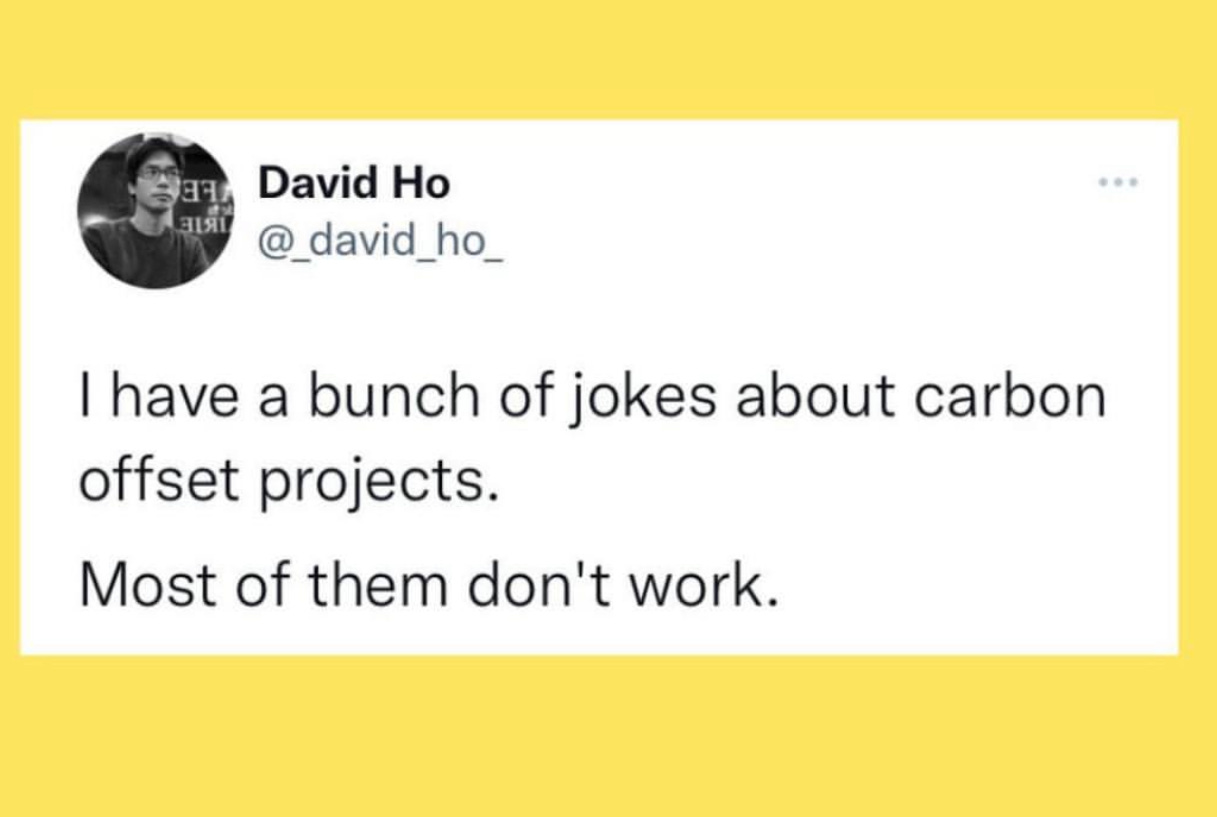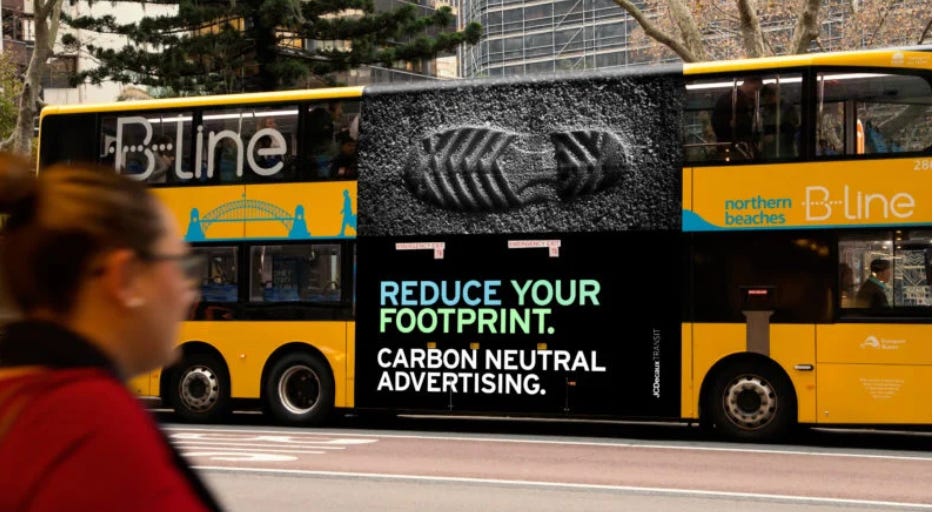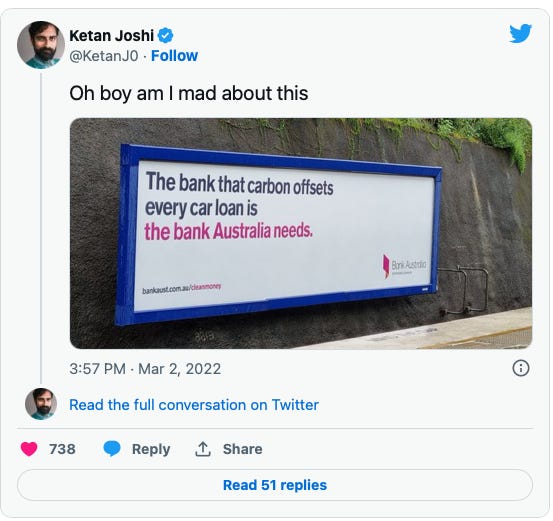So it’s all rather timely. Last month the Australian competition watchdog, the ACCC, announced it had launched a crackdown on companies making dodgy greenwashy offsetty claims. As COP27 wraps, UN experts have also warned in a special report that nations (and they single out Australia) must clamp down on offsetting. I think there are a lot of brands and marketers out there who are worried they are going to be pulled up on their vague, wobbly ESG claims. And there are a lot of us - citizens - wanting to know how to navigate the legit v dodgy slogans so we can be better consumers.
Me, I’ve been called upon recently to spruce various brands’ highly spurious net-zero claims on my podcast; I’ve turned these sponsorships down, but noted my competitors did not…because, I suspect, they simply do not know how to navigate the whole palaver.
Which is what we will try to do today…Navigate. The palaver.
To help me out, I got Polly Hemming from Australia Institute's Climate & Energy program to do a quick video (above) to answer some common quandaries (including whether ticking the “offset my flight” box amounts to anything). Hoorah for Polly! You may also want to check out her Saturday Paper feature on the topic. And follow her on Twitter.
** In the video I promise to put in the details for writing to your local MP or ACCC. This is at the bottom of the his post.
In addition, I’ve dot-pointed and numbered-listed to buggery the complex issue below. And inserted some comical (if it weren’t so tragic) examples of ludicrous greenwashy offsetty claims. I’ve tried to make it as digestible as possible. Do share this around the joint. It’s important.
OK, so let’s get into it
We have had denialism, doomism and delayism (witness: Pete Dutton’s nuclear hoo ha, per my recent post). But there’s now another threat broiling in the climate soup that will put the emergency on simmer once again: the carbon offsetting cluster of f*ckery. It goes like this…
On one page of a newspaper we have big polluters (even petrol companies!) declaring they’ll be net-zero by 2050! Sounds great. The slightly finer print says they’ll get there by carbon offsetting. Which also sounds… pretty great.
On the next page of this metaphorical newspaper, however, you have experts telling us the offsets are not real and that we’re being conned by the FFs. Net-zero is an accounting trick being played on all of us by the big polluters who will keep on pollut’n on, we’re told!
Yep, net-zero commitments are not the answer; carbon offsetting is dodgy. (We get to why in a moment.)
But the real bloody worry is this: All the convolution and conflicting information will cause everyday people to tune out and give up… again! Do we offset or not? Do we support brands that are committing to net zero goals or not? Shit, I give up!
What exactly are carbon offsets?
There are two ways to reduce greenhouse gases in the atmosphere:
1. Stop emitting them in the first place 👍🏽
2. Soak up or suck out what is already up there🤞
To do the latter we offset, which entails drawing down the CO2 (and other GHGs) from the atmosphere and storing it in the ground (Direct Carbon Capture or DCC) or in other natural storage facilities, such as trees and mangroves (which naturally suck or soak up the CO2), as benign carbon.
So when a company offsets they are *ostensibly* planting enough CO2-absorbing trees (as the most common example) to counter the emissions that they have just dumped into the atmosphere to produce their hamburger or T-shirt or plane trip.
Or, more accurately, they pay someone to plant said trees. It’s a swap for swap thing. Or a passing-of-the-buck thing.
Or, shall we say it straight? It’s an offloading thing.
The same happens when you tick the “offset emissions” button when you buy a plane ticket. You pay the carrier to pay someone to plant a bunch of trees on your behalf. Buck passed, or offloaded, for under $2.
Very important thing to know:
According to the IPCC, we are meant to be reducing GHGs primarily by stopping the emissions in the first place (85-95%). We offset only for the remaining 5-15% emissions which can’t be avoided or eliminated, things like concrete and steel production and other production measures where the alternative technology hasn’t been developed yet.
Sadly this is not even close to what happens. Instead, offsetting has become the primary focus for GHG reductions. Many companies have few plans to reduce their emissions at all and are making their “net zero”, “carbon neutral” claims based 100% on offsets/passing the buck.
Now this is bad. But it gets dodgier…
Although, before we move on:
I’ll just flag, these offsets are also called carbon credits and in Australia we have Australian Carbon Credit Units (ACCUs; pronounced “ac-uuse”). The process is also called Carbon Dioxide Removal (CDR), carbon drawdown or sequestration. (No one in this making it easy for us here!)
And what exactly is net zero?
Correct me if I’m wrong, but I think the bulk of people out there confuse zero with net zero, or “carbon neutral” as it’s sometimes called.
Zero emissions means a product or service does not produce any greenhouse gases (CO2 and methane being the most common).
Net zero is an accounting equation. When a company (or country) says it’s net zero it does not mean it has come up with epic ways to cut emissions. It merely means it has offset (or paid to offset) the emissions that they are still pumping into the atmosphere. The polluting has just been moved to another column on the ledger.
But! Pretty soon things gets well dodgy…
I’m going to have to break this down into numbered points.
Planting trees is currently the most touted and effective/accessible offsetting technique.
BUT!!!!
To offset all the emissions in all of those net-zero commitments being made we’d need a land mass the size of all current global crop land (the land we use for food!). The international Land Gap Report was released two weeks ago and made the point that we’re talking a land mass bigger than Australia!
But wait! In Australia, and in much of the world, carbon offsetting via forests does not happen from the planting more trees.
Instead:
It happens by paying “someone” to NOT cut down trees that (presumably) MIGHT be deforested at some point down the track.
Yes, you read that triple negative, inverted hypothetical statement correctly! It’s not unlike paying a murderer to avoid murdering someone, to cancel out the murder you just committed. Madness!
In fact,
Only 5% of offsets actually remove CO2 via tree planting and DCC. The rest is indirect avoidance.
As you can imagine, it’s really, really hard to prove that a tree or forest MIGHT be at risk of being cut down. In fact, in many cases, carbon credits are being issued for trees that could NEVER have been cut down. Which is like paying someone to quit smoking when they didn’t smoke in the first place.
Further, there are no sufficiently official governing bodies that police the above. How do we - the consumer or the marketer - know whether these trees were planted? How do we know if they were going to be planted anyway or whether the forests saved from deforestation were ever under threat?
We don’t. This is a fast becoming a top-line issue in the climate wrestle, both internationally and in Australia.
So much so:
Australian whistleblower Professor Andrew McIntosh has claimed up to 80% of carbon offsets aren’t real.
As Polly explains in our chat, in Australia this stuff is meant to be regulated by the Australian Government. It’s not. And even more worryingly we have a government-sponsored offsetting system, ClimateActive, which certifies FF companies like AGL.
Which brings us to the big doozy…
6. When we focus on offsetting instead of eliminating, we hold back real progress. The chair of the Land Gap Report told The Australian “offsets can’t be a device which big emitters use not to […] do something about reducing emissions”. UN Secretary General Antonio Guterres has warned the same.
7. CO2 has a very long longtail - it hangs around in the atmosphere wreaking havoc for thousands of years. But the offsetting modelling works to a 25-year (sometimes 100-year) timeframe. For example, an offsetting scheme will commit to a tree being in existence as a carbon storage vessel for 25 years, not thousands. Few trees live longer than 100 years. With bushfires and floods on the rise (quelle irony), there is little guarantee they’ll even last the 25 years.
Thank you for reading this far! Bear with me. I’ll continue with two more points:
When you try to argue against carbon offsetting, things get even tricker. Off-setters like to say that the money paid for offsetting goes to good causes - sustainable projects, farmers, First Nations people and so on. Which might be true in cases. But what happens is that these vulnerable groups become pawns in the debate when other solutions (like reducing emissions) are put forward. When a concerned humans criticises offsetting they are often accused of harming farmers and indigenous causes. I have experienced this often. It’s a strawman argument. The worst!
Leaving aside all the problems with offsetting that I’ve outlined, even when a company claims to have gone “net zero” or “carbon neutral”, the fine print on these claims is that they are net zero for their “operations” only, like the running of the office or warehouse, and not the actual product itself. It’s a cherry-picked statement at best!
So where does this leave us?
Well, as Polly explains, there is literally no body, no resource for checking that a brand or company or country’s offsetting is effective (and thus their net-zero claims valid).
But I would argue two things.
Does it matter when we know only 5% of offsetting credits are actually removing CO2 anyway?
Is it not all a moot point when offsetting is not the solution (or is at least a solution of last resort for those 5-15% of emissions we just can’t get to at the moment)?
I think we can avoid the kerfuffle and cut straight to the chase on this. We need to be supporting emission cutting claims. We can use common sense to spot and assess these. Is the brand switching to renewables? Are they turning their fleet electric? Are they cutting back on waste and inefficiencies?
We can ask a brand how much of their net-zero pledge is based on offsets. It should be under 15%.
We can demand the same of our country.
The current Australian Government has committed to net zero by 2050. But it is still approving new coal and gas projects and subsidising current FF companies. We have to demand they focus on cutting emissions not offsetting. To this end, as promised….
Here are the details for taking action
Contact the ACCC here and make a general complaint stating that you have no idea what claims you can trust, or complain about a specific business or advertisement you’re concerned about.
Write to Chris Bowen MP, the climate minister and ask him to stop subsidising fossil fuels. Here’s his email address: chris.bowen.mp@aph.gov.au. Remember, MPs must read all letters and emails sent to them.
And you can tell Climate Active to stop certifying fossil fuel greenwash. Here’s their email: climate.active@industry.gov.au
Crikey, that was a marathon. Please do flag if I’ve missed anything or if you have an unanswered quandary. I’ll ask Polly to dive into the comments.
Somewhat related, this week’s Wild episode is all about greenwashing in the fashion industry with my dear friend Clare Press. Clare flags a term I like. She refers to a fashion label in Denmark that has quit offsetting and is instead “insetting” - taking measures within the company to absorb the costs of emissions they can’t eliminate. We also cover off whether pleather is sustainable, whether the stuff we donate to St Vinnies just goes to landfill (yup) and whether when I return something online it, too, just wends up landfill and not back on the rack (double yup).
Until next rant,
Sarah xx









Share this post